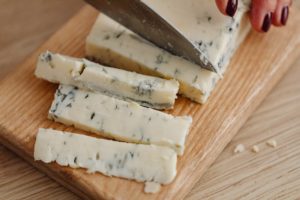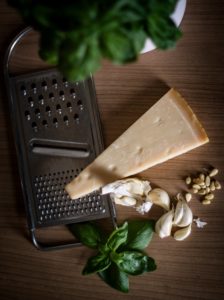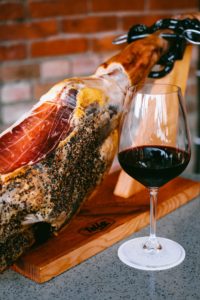Foods Protected by a Shield
By: Arham Jain
The Protected Designation of Origin (PDO)
 The PDO is a type of geographical indication system developed by the European Union to safeguard certain food-related products which are of great historical and sentimental importance to a certain region’s culture and economy. Started in 1992, the program aims to preserve the customary practices, methods, and traditional know-how of these illustrious foods which have been passed down generation by generation in a rite of passage.1 This system also protects the livelihood of hundreds of thousands of artisans and craftsmen, who are carrying on the modus operandi of their ancestors and providing us with these products of the most excellent quality.
The PDO is a type of geographical indication system developed by the European Union to safeguard certain food-related products which are of great historical and sentimental importance to a certain region’s culture and economy. Started in 1992, the program aims to preserve the customary practices, methods, and traditional know-how of these illustrious foods which have been passed down generation by generation in a rite of passage.1 This system also protects the livelihood of hundreds of thousands of artisans and craftsmen, who are carrying on the modus operandi of their ancestors and providing us with these products of the most excellent quality.
The Appellation d’origine contrôlée (AOC)
 “Terroir” is a concept popularized by French winemakers which claims that the land on which a crop is grown, the environment, and the habitat all leaves a noticeable trace on the taste, aroma and other properties of the final product derived from it. In France, the Appellation d’Origine Contrôlée (AOC) is a label based on the terroir system which dates to the year 1411, when the famous blue cheese Roquefort was standardized by Parliamentary Law. The AOC grants a certificate of authenticity to the business which meets its requirements regarding products such as wine, cheese, butter, and oils.2 Nowadays the PDO has largely replaced the AOC, which is used only for wines now.
“Terroir” is a concept popularized by French winemakers which claims that the land on which a crop is grown, the environment, and the habitat all leaves a noticeable trace on the taste, aroma and other properties of the final product derived from it. In France, the Appellation d’Origine Contrôlée (AOC) is a label based on the terroir system which dates to the year 1411, when the famous blue cheese Roquefort was standardized by Parliamentary Law. The AOC grants a certificate of authenticity to the business which meets its requirements regarding products such as wine, cheese, butter, and oils.2 Nowadays the PDO has largely replaced the AOC, which is used only for wines now.
Rules and Regulations
The PDO has set standards, not only for the specific location of production but for every minute detail regarding the foods it encompasses. Everything from when the crops are to be harvested, to the duration of aging time for some cheeses and wines, and even what the cattle grazes on is standardized and these standards are enforced fiercely. It even has rules stating how far the processing facility can be from the farm and dairies. Only if a product meets the strict and rigid requirements can it be deemed worthy of bearing a PDO approval logo. Let’s explore some of the food products that bear this shield.
Gorgonzola
 This soft and smelly cheese is exclusive to only 29 dairies in the Italian regions of Piedmont and Lombardy. With more than $800 million dollars at stake the protection of this cheese is extremely important. To make this cheese unpasteurized cow’s milk is used. As the milk is curdled, the fungus Penicillium glaucum is added to the mix and later the set cheese is punctured which gives the cheese its signature blue veins and funky smell. The texture of the cheese is determined by the length of the ageing process, a minimum of 2 months gives a soft, mild, and creamy variety, while 3+ months yields the firm and pungent variety.3
This soft and smelly cheese is exclusive to only 29 dairies in the Italian regions of Piedmont and Lombardy. With more than $800 million dollars at stake the protection of this cheese is extremely important. To make this cheese unpasteurized cow’s milk is used. As the milk is curdled, the fungus Penicillium glaucum is added to the mix and later the set cheese is punctured which gives the cheese its signature blue veins and funky smell. The texture of the cheese is determined by the length of the ageing process, a minimum of 2 months gives a soft, mild, and creamy variety, while 3+ months yields the firm and pungent variety.3
Parmigiano Reggiano
 Called the “King of Cheeses”, the Parmesan market is worth a staggering $2.5 billion and is one of Italy’s major exports. Its Italian name, Parmigiano Reggiano, is traced back to the two provinces of Parma and Reggio Emilia, and, along with Bologna, Modena, and Lombardy, are the only places legally authorized to make true Parmesan Cheese. While outside the EU, any similar cheese can be named Parmesan; the full Italian name is reserved for only the genuine product. Only 329 dairies in the world can boast of being certified to produce this mouth-watering delight.
Called the “King of Cheeses”, the Parmesan market is worth a staggering $2.5 billion and is one of Italy’s major exports. Its Italian name, Parmigiano Reggiano, is traced back to the two provinces of Parma and Reggio Emilia, and, along with Bologna, Modena, and Lombardy, are the only places legally authorized to make true Parmesan Cheese. While outside the EU, any similar cheese can be named Parmesan; the full Italian name is reserved for only the genuine product. Only 329 dairies in the world can boast of being certified to produce this mouth-watering delight.
The process is started with 131 gallons of raw unpasteurized cow’s milk, mixed with fermented whey and rennet, which is pumped in copper vessels. The whey provides the thermophilic lactic acid bacteria, and the rennet curdles the milk. The set curds are then split, left to settle, and then molded into giant wheels. After brining for 25-30 days, the cheese is left to ferment for 12 months.4 After it passes all adequate checks, it is ready to be enjoyed.
Champagne
 Champagne is a sparkling wine from the region of the same name from France. 300 million bottles are produced each year in this relatively small part of France. The exclusive wine is made from a variety of grapes grown in the region such as Pinot noir, Pinot meunier and Chardonnay. The cooler climate of this region gives the grapes the proper acidity for sparkling wine production. The ancestral method of producing champagne, which is called Méthode Traditionnelle, includes a primary fermentation in oak or steel barrels and a second one inside the bottle itself. It’s the second part which gives the wine that effervescence effect it is known for. While wines all around the globe are made from this methodology, they are required to be labelled “sparkling wine.”5 Many manufacturers outside the EU ignore these laws and continue calling their wine champagne. The Comité Champagne continues to challenge these labels to protect the identity of this heavenly drink.
Champagne is a sparkling wine from the region of the same name from France. 300 million bottles are produced each year in this relatively small part of France. The exclusive wine is made from a variety of grapes grown in the region such as Pinot noir, Pinot meunier and Chardonnay. The cooler climate of this region gives the grapes the proper acidity for sparkling wine production. The ancestral method of producing champagne, which is called Méthode Traditionnelle, includes a primary fermentation in oak or steel barrels and a second one inside the bottle itself. It’s the second part which gives the wine that effervescence effect it is known for. While wines all around the globe are made from this methodology, they are required to be labelled “sparkling wine.”5 Many manufacturers outside the EU ignore these laws and continue calling their wine champagne. The Comité Champagne continues to challenge these labels to protect the identity of this heavenly drink.
Jamón Ibérico
 This lavish ham is made exclusively from Black Iberian Pigs, or their hybrid with Duroc pigs. After younglings are fattened on maize and barley for a few weeks, they are allowed to roam in pastures and oak groves where they feed on grass, herbs and most importantly on acorns and chestnuts. With no more than 2 pigs per hectare, they have ample room to roam and get fat. After harvesting the hind legs are stored and cured in salt for 15-20 days. They are hung for 2 months in a temperature-controlled room and then for 6-9 months in a well-ventilated room. Finally, it is aged in cellars anywhere from a year to many years. All this process creates four labels, the black label is the most superior product, reserved for pigs with 100% Iberian “de bellota” pig who are raised free range and fed on acorns. Red label indicates partial Iberian breeds and Green indicates that they were fed on a mixed diet. While the one from intensive farming gets a white label.6
This lavish ham is made exclusively from Black Iberian Pigs, or their hybrid with Duroc pigs. After younglings are fattened on maize and barley for a few weeks, they are allowed to roam in pastures and oak groves where they feed on grass, herbs and most importantly on acorns and chestnuts. With no more than 2 pigs per hectare, they have ample room to roam and get fat. After harvesting the hind legs are stored and cured in salt for 15-20 days. They are hung for 2 months in a temperature-controlled room and then for 6-9 months in a well-ventilated room. Finally, it is aged in cellars anywhere from a year to many years. All this process creates four labels, the black label is the most superior product, reserved for pigs with 100% Iberian “de bellota” pig who are raised free range and fed on acorns. Red label indicates partial Iberian breeds and Green indicates that they were fed on a mixed diet. While the one from intensive farming gets a white label.6
Expanding Horizons
The PDO system has persisted in defending the identity of the authentic food products of Europe; however, the system is not limited to products of European origin. A spokesperson for the European Commission told Food Navigator: “The EU Quality Scheme is by no means a restricted scheme for the EU producers but is open to producers from third countries as long as they satisfy the conditions of the referenced regulation. Now, there are 25 names from different third countries registered under the EU Quality Scheme.” Food items such as the Cambodian Pepper and Turkish Fig are among the numerous non-EU products protected by the PDO label.7
This label has also been used as a political and economic weapon.8 In September of 2020, India petitioned for its Basmati rice to be declared a protected product that could only be grown in India. This infuriated India’s long-time enemy, Pakistan, whose enormous Basmati export, second in worth only to India itself, would dwindle if this were to be allowed. They have since been fighting a cold war over the right even after Pakistan suggested they claim Joint Heritage.9
Conclusion
All this goes to show the importance of the PDO system. It not only preserves the cultural interests of communities but also the economic interests, while ensuring we get to enjoy the most unadulterated and authentic products!
Bon Appétit
[1] https://en.wikipedia.org/wiki/Protected_designation_of_origin
[2] https://www.inao.gouv.fr/Les-signes-officiels-de-la-qualite-et-de-l-origine-SIQO/Appellation-d-origine-protegee-controlee
[3] https://www.insider.com/how-italian-gorgonzola-cheese-is-made-italy-2019-4
[4] https://www.youtube.com/watch?v=61bY4K_JWkw
[5] https://www.pernod-ricard.com/en/media/champagne-production-method
[6] https://medium.com/the-bellota/a-brief-history-of-jam%C3%B3n-ib%C3%A9rico-bfa0a1d009c0
[7] https://www.foodnavigator.com/Article/2016/02/22/Cambodian-and-Turkish-foods-get-EU-protected-origin-status
[8] https://www.youtube.com/watch?v=wvIIpbCYMzs
[9] https://www.thehindubusinessline.com/economy/agri-business/how-eu-could-grant-exclusive-gi-tag-for-indian-basmati-rice/article34578940.ece
[10] Featured image: https://burst.shopify.com/photos/cheers-wine-and-cheese?q=wine+and+cheese+hamper
[11] Image, PDO: https://en.wikipedia.org/wiki/Protected_designation_of_origin#/media/File:Protected-designation-origin-logo-fr.png
[12] Image, AOC: https://commons.wikimedia.org/wiki/File:Appellation_d%E2%80%99Origine_Contr%C3%B4l%C3%A9e_logo.svg
[13] Image, Gorgonzola: https://www.pexels.com/photo/a-person-cutting-gorgonzola-cheese-6660134/
[14] Image, Parmesan Reggiano: https://www.pexels.com/photo/food-ingredients-recipe-cook-33249/
[15] Image, Champagne: https://www.pexels.com/photo/clear-wine-glass-with-yellow-liquid-3995674/
[16] Image, Jamón Ibérico: https://www.pexels.com/photo/photo-of-a-glass-of-wine-beside-jamon-4871277/
About the Author:

Arham Jain is an up and coming student from India passionate in food science, cooking and everything food related. He is always excited to learn about the new innovations in the food science and culinary world. His hobbies include reading, gardening and content writing.






Leave a Reply